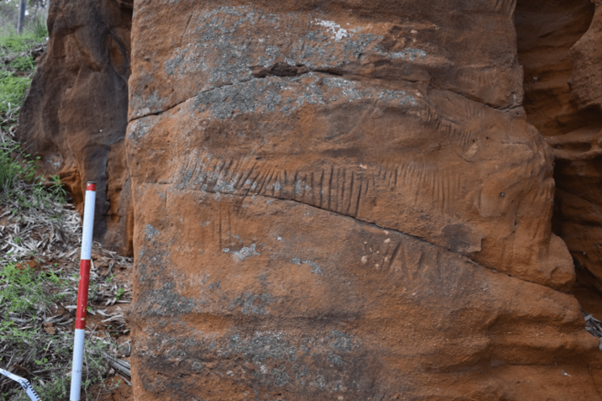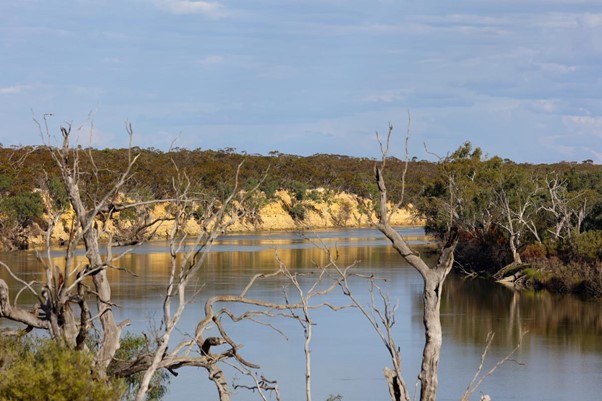A project to identify and map rock art sites in a long section of the River Murray in South Australia has prompted a call for greater understanding and protection of the region’s ancient Aboriginal heritage.

Thurk petroglyphs. Photo: Courtesy of the River Murray and Mallee Aboriginal Corporation
The rock art project, undertaken by archaeologists at Flinders University in partnership with the River Murray and Mallee Aboriginal Corporation, (RMMAC) is exploring Aboriginal rock art and rock shelter occupation deposits in what’s being described as the “Upper Murray River Gorge.”
It’s a spectacular but little-known region. Even the description might confuse people as it’s not frequently used to describe that area of river between Morgan in the west and Overland Corner in the east, a distance of about 90km by road and considerably further by meandering river.

Murray River cliffs at Taylorville. Photo: Sandy Horne
The local council said, perhaps sensing a tourism opportunity: “The Murray River has its own mesmerising riverside gorge, comparable to Northern Territory’s Katherine Gorge.”
Don Pate, Emeritus Professor of Archaeological Science at Flinders University said the modern river was established between 6,000 and 8,000 years ago.
“The gorge section of the Lower Murray River refers to the region that is bordered by high limestone cliffs,” he said.
“The river morphology exhibits great variability with the state of SA. From the state border to Overland Corner (40km east of Waikerie) the river meanders through a wide alluvial valley bordered by tall limestone cliffs.
“Below Overland Corner, the Murray has dissected the uplifted limestone Pinnaroo Block producing steep-sided gorge topography.
“Limestone cliffs in this region tower 30-40m above the river bottom. The limestone cliffs decrease in height 30km south of Roonka near Swan Reach, and wide alluvial flats emerge again. Numerous swamps and broad, shallow lakes occur in the Coastal Zone which continues to the river mouth at Lake Alexandrina.”
The rock art research, funded by the Australian Research Council since 2021, was to conduct the first archaeological excavations of stratified rock shelter sites in the region in more than 50 years, and record what’s described as a “threatened and rapidly diminishing corpus of rock art”.
Traditional owner and RMMAC spokesperson Fiona Giles said at the project launch: “It will be a stepping stone in recording our history for future generations.”
The first research from the project is now being published.
“The Murray River has its own mesmerising riverside gorge, comparable to Northern Territory’s Katherine Gorge.” Mid-Murray Council
A paper in the January edition of Rock Art Research explores the substantial rock carvings at a place referred to in the paper as “Thurk” (the traditional Aboriginal place-name for the region), an area named by European settlers as Kingston-on-Murray.
Lead author of the paper, Professor Amy Roberts from Flinders University, said the Thurk Aboriginal petroglyphs (engravings) comprise at least 524 motifs made up predominantly of geometric line elements as well as a small number of other ‘simple’ geometric motifs, two ‘bird tracks’, one figurative design (a ‘fish’) and a possible anthropomorphous figure.
Roberts said the paper also provided “the first synthesis of rock art sites/complexes and motifs from other sites on the Murray River as well as visual symbols recorded from senior Aboriginal ‘knowledge carriers’”.
“These allow us to consider the relationship of Thurk to other cultural places and to highlight and honour the traditional knowledges and beliefs which underpin the rock art,” she said.
“Thurk’s placement within the riverscape, its unique geological canvas, lack of observable ‘domestic’ archaeological evidence combined with it being the likely upstream extent of Murray River rock art in South Australia contribute additional dimensions to its cultural significance.
“That Thurk’s rock art, and the broader site, have been desecrated by gratuitous graffiti, vandalism and infrastructure brings into sharp focus Australia’s poor record of heritage protection and provides a challenge to current and future generations of non-Aboriginal people to remedy this past.”
Words: Ian Mannix



